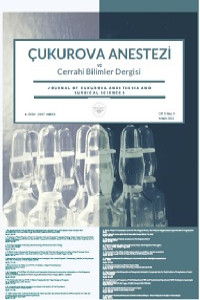Articles
Case Reports
Reviews
Issue Editorial Board



Aim & Scope
The aim of the journal is to announce offering of national and international scientific environment and share high quality research studies, case studies and reviews conducted in the field of anesthesia, pain medicine, intensive care and surgical sciences both in Turkey and abroad; and to contribute to the development of scientific communication by establishing a continuous educational platform.
Journal of Cukurova Anesthesia and Surgical Sciences (J Cukurova Anesth Surg ) is published online three times a year (April, August, December). Special or supplement series may also be published where necessary. Manuscripts submitted to the journal are evaluated by independent peer reviews according to double blind peer review system. Scientifically reviewed manuscripts can be freely accessed through the internet without financial, legal and technical barriers. These manuscripts can be read, downloaded, copied, distributed, printed, scanned, linked to full texts, indexed, transferred as data to the software and used for any legal purpose. Authors and copyright owners agree that all users have free access.
Author Guidelines
Please read the spelling rules and publication principles before submitting your article.
Cover Page: The title should be simple and understandable (in Turkish and English). Name, surname and title of all authors, the name and city of the institution they work for should be included on this page. The name, address, telephone, fax, mobile phone and e-mail information of the author should also be added to this page.
On the first page of the article file, only the author information and, if applicable, the related notes should be found on the first page of the article. Article text should start from the second page.
The abstract should have a maximum length of 250 words. The Objective should include Materials and Methods, Results and Conclusion. Keywords with at least 3 (three) words should be written with a space between the abstract.
Research article format; Introduction, material and method, findings, discussion and conclusion
Case presentation format; Introduction, case report, history, tests, progress, treatment and outcome, discussion-literature review, recommendations
References
The authors themselves are responsible for the accuracy of the resources.
References should be written on a separate page and should be numbered according to the order of transition.
If the name is not given in the sentence, the source number should be given in superscript before the point sign.
Example: (-------- is used in prophylaxis21.)
Example: (---------------- Fields ve ark.28 sağlıklı, kilolu ve obez adolesanlarda----------------)
Year, volume, start and end pages should be given in journal sources, but only the year should be stated in book sources.
Example: (Sinclair DR, Chung F, Mezei G. Can postoperative nausea and vomiting be predicted? Anesthesiology. 1999; 91: 109-18)
Example: (Malagelada J-R, Malagelada C. Nausea and vomiting.): 10S ed, Feldman M, Freidman LS, Brandt LJ (Eds).
If there are more than two consecutive sources, the first and last ones should be given a "-" sign:
Example: (-------ihtiyatla hareket etme eğilimi olarak tanımlanmıştır1-3.)
References should contain the full surnames of the authors and the first letters of their names.
Example: (Ilgınel MT, Tunay DL, Güneş Y. Epilepside perioperatif yönetim ve anestezi. Arşiv Kaynak Tarama Dergisi. 2018;27:39-69.)
If the number of writers in the source is 3 or less, all authors should be mentioned. the source should be written.
Example: (Koivuranta M, Läärä E, Snåre L, et al. A survey of postoperative nausea and vomiting. Anesthesia. 1997; 52: 443-9.)
Journal names should be shortened according to Pubmed.
Example: (Br J Anaesth., Anesth Analg., J Pharmacol Sci.)
Authors are responsible for the correctness of references and spelling.
Manuscripts and punctuation marks must comply with the following examples.
The source is a magazine;
The author should be written in full capitalization, and the first name should be written as first letter and larger. Title of article. The journal is abbreviated to Index Medicus. Year: Volume: First page number-Last page number
Example: (Ilgınel MT, Tunay DL, Güneş Y. Epilepside perioperatif yönetim ve anestezi. Arşiv Kaynak Tarama Dergisi. 2018;27:39-69.)
If the source is a book;
Name (s) of the surname of the author (s). The name of the book. What is the pressure? Publication Place: Printing House, Publication Year.
Example: (Ropper AH, Brown RH. Adams and Victor's Principles of Neurology. 8th ed. New York, McGraw-Hill, 2007.)
If a chapter from the book was used as a source;
Name (s) of the surname of the chapter author (s). Section title. The name of the book. What is the pressure? (First name and last name (s) of ed and Eds. Editor (s): First page number-last page number of the section. Printing place, Publisher, Year of printing.
Example: (Phillips MK, Gain P. Hypertension and stroke. Hypertension: Pathophysiology and Management, 2nd ed (Eds JH Laragh, BM Brenner): 495-8. London, Ran Press, 1985.)
If the website is shown as source;
The name of the Web site. (accessed date)
Sample:
World Health Organization (WHO).
Available from: http://www.who.int/mediacentre/factsheets/fs311/en/ Access date: 15Position2017.)
The source thesis is;
First name of the author's surname. Title of the thesis (thesis). Name of the city, University name (if university), Year.
Example: (Tunay M. Kilolu ve obez kadınlarda grup görüşmelerinin vücut ağırlığına, iyilik haline ve sağlık denetim odağına etkisi (Uzmanlık tezi). Adana, Çukurova Üniversitesi, 2015.)
Tables:
1. Tables should be written on a separate page with a single line spacing.
2. Each table should have number and descriptive information above it.
3. If abbreviations are given in the table, these abbreviations can be defined as subtitles under the table and alphabetical order.
4. When previously printed or electronically published tables are used, written permission must be obtained from both the author and the printer and this must be sent to the editor of the journal by fax or mail.
5. Transverse and longitudinal lines should not be used in the table, only a straight line should be drawn at the top and bottom.
6. Tables should not be repeated in the text.
7. Tables should not be placed in writing.
8. Tables should be in the file to which each post is sent to a table.
Figure Graphic Pictures and Subtitles:
1. Subtitles should be written on a separate page with two lines spaced apart.
2. Numbered according to the order in the text and abbreviations in figures, graphics and pictures, abbreviations should be placed in the alphabetical order below the subtitle.
3. Tables, figures and graphics should not be placed in the writing.
4. Magnification ratio and staining technique should be explained in microscopic pictures.
5. When using previously printed or electronically published figures, graphics and illustrations, written permission must be obtained from both the author and the printer, and should be sent to the editor of the journal by fax or post.
6. Written permission must be obtained when using the images of the persons to be recognized.
7. The explanations of the figures should be written at the end of the file to which the manuscript is sent.
8. Table, figure and graphs should be mentioned in the text.
9. The pictures / photos should be colored, the details should be clearly visible and clear.
10. Figures, pictures / photos are separate. jpg file should be added to the system.
11. Image and photo files should not be less than 100 pixel / inch, 8 cm wide and 300dpi.
Ethical Principles and Publication Policy
Price Policy
The Journal of Çukurova Anesthesia and Surgical Sciences does not charge any fee for the authors. A completely free journal for writers and readers.



